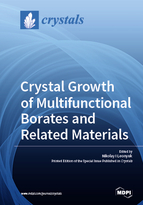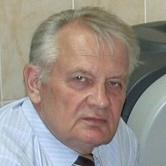Crystal Growth of Multifunctional Borates and Related Materials
A special issue of Crystals (ISSN 2073-4352). This special issue belongs to the section "Inorganic Crystalline Materials".
Deadline for manuscript submissions: closed (20 December 2018) | Viewed by 25745
Special Issue Editor
Interests: crystal growth; crystallography; crystal chemistry; crystal morphology; liquid phase epitaxy; micro- and nanocrystallization; inorganic compounds
* Passed away in May 2020
Special Issues, Collections and Topics in MDPI journals
Special Issue Information
Dear Colleagues,
Most borate materials have attracted considerable attention, owing to their remarkable characteristics and potential applications. For instance, they demonstrate nonlinear optical and piezoelectric effects (CsB3O5, LiB3O5, CsLiB6O10, KBe2BO3F2, Sr2Be2BO7, K2Al2B2O7, Ca4GdO(BO3)3, b-BaB2O4, R2CaB10O19 (R = rare earth metals), RM3(BO3)4 (М = Аl, Cr, Ga, Fe, Sc), luminescent (RBO3) and magneto-electrical properties (RFe3(BO3)4, RСr3(BO3)4, HoAl3(BO3)4, TbAl3(BO3)4), etc.
Nowadays, more than 1000 representatives of the anhydrous borate family are listed in the Inorganic Crystal Structure Database. These compounds are characterized by the great variety in their crystal structures, caused in the linkage of planar BO3–triangles and BO4–tetrahedra as fundamental structural units, and this leads to glass formation in viscous borate-based melts. Investigations of “conditions–composition–structure-properties” relationships can help to develop growth in technology of single crystal components for high performance electronic and optical devices for industrial, medical and entertainment applications.
The structural stability of many silicates, phosphates and germanates also depends on the delocalization of formal charges of the AnOm (A=Si,Ge,P) anions as a result of their polymerization. The regular variations in their structural motifs makes it possible to forecast (optimistically, more or less) new phase systems for the synthesis of advanced materials as well, because currently most of these single crystals are not available in good size or quality. A further analysis of these inorganic polymer structures will set forth the judicious ways towards better understanding the growth mechanisms of multifunctional crystals, and this Special Issue is intended to fill this gap in the field.
Prof. Dr. Nikolay I Leonyuk
Guest Editor
Manuscript Submission Information
Manuscripts should be submitted online at www.mdpi.com by registering and logging in to this website. Once you are registered, click here to go to the submission form. Manuscripts can be submitted until the deadline. All submissions that pass pre-check are peer-reviewed. Accepted papers will be published continuously in the journal (as soon as accepted) and will be listed together on the special issue website. Research articles, review articles as well as short communications are invited. For planned papers, a title and short abstract (about 100 words) can be sent to the Editorial Office for announcement on this website.
Submitted manuscripts should not have been published previously, nor be under consideration for publication elsewhere (except conference proceedings papers). All manuscripts are thoroughly refereed through a single-blind peer-review process. A guide for authors and other relevant information for submission of manuscripts is available on the Instructions for Authors page. Crystals is an international peer-reviewed open access monthly journal published by MDPI.
Please visit the Instructions for Authors page before submitting a manuscript. The Article Processing Charge (APC) for publication in this open access journal is 2600 CHF (Swiss Francs). Submitted papers should be well formatted and use good English. Authors may use MDPI's English editing service prior to publication or during author revisions.
Keywords
- Crystal Growth
- Crystallography
- Crystal Chemistry
- Borates
- Multifunctional Materials






